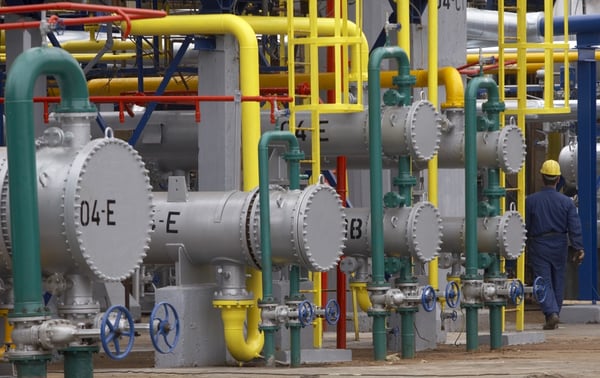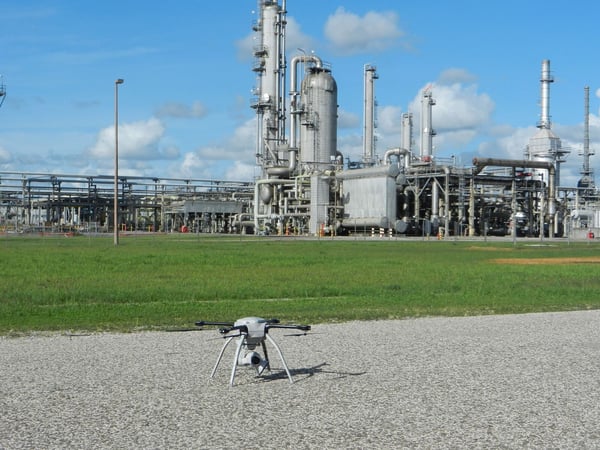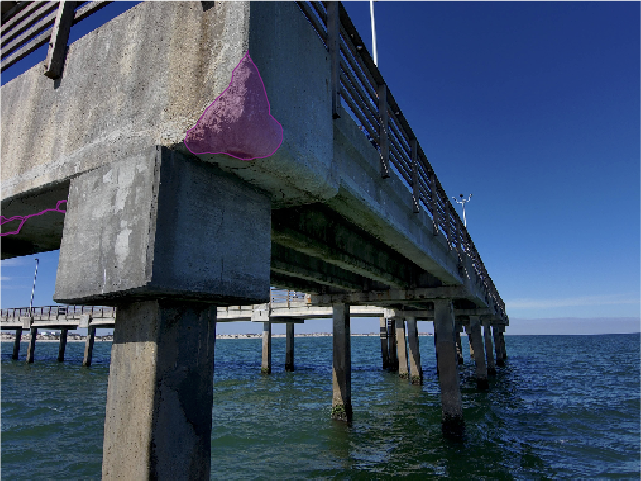Drones provide many possibilities in a wide range of commercial and industrial applications. From aerial photography and video shooting, to surveys and inspection of structures, the list is endless. Custom drone designs with special sensors are becoming common in the oil and gas industry, where they are helping them to safely and cheaply monitor their assets remotely.

Other than the usual photography, the drone technologies can gather additional information such as gas leaks and thermal images. Pairing the UAVs with the appropriate sensors enables the teams to gather comprehensive data from the remote locations at the fraction of the traditional methods.
One potential and interesting application is the detection of methane gas leaks which are common and a challenge in the oil and gas industry. Usually, the methane gas leaks present risks to the community, users, workers and the environment. The oil and gas companies have the responsibility of preventing and addressing any leaks in the upstream, midstream or downstream components of production and distribution systems.
While traditional methods have been used for a long time, they are slow, risky and costly. Further, inspection workers accessing contaminated areas face a wide range of risks when exposed for long periods. To overcome some of these and other challenges, companies can deploy drones, which provide faster, cost-effective and safe unmanned aerial methane detection solution. A typical application involves attaching a gas sensor to the drone integrated with image, video and location and other sensors or technologies that support the identification of leaking sections of the infrastructure.
Why use drones to detect methane gas leaks in the oil and gas industry
Methane, which is the main component of natural gas, has several negative impacts when released to the environment. This is especially a challenge in the oil and gas industry. With global warming becoming a challenge every day, all companies and especially those dealing with large amounts of methane need to prioritize the prevention and reduction of the emissions and leakages.
Although the pure gas is not toxic in low quantities, extended exposure to humans can lead to some health complications. For this reason, it is good practice to limit the time humans spend in contaminated environments. This may affect the accuracy, cost, and effectiveness of the manual inspections, hence the need for alternative methods such as the drones.
Generally, UAVs provide an ideal solution that offers more safety and faster analysis while reducing exposure to hazardous environments.

How methane gas detection works
The methane detection drones detect the leaks by the use of light reflection and absorption sensors. The sensors emit eye-safe lasers which are reflected back in specific ways upon hitting certain matter such as gases. Analyzing the reflected beam enables the drones to pinpoint leaks, including the very small ones. Generally, the sensors can identify the methane spectral signature based on the reflected light; hence determine the presence or absence of the gas.
In a typical inspection, a drone equipped with laser beam sensors flies over the suspected area at a set height. The sensor then beams a laser light on the area while capturing the reflection. If there is the presence of methane gas, it absorbs part of the light and this can be seen in the reflection.
Drones paired with high definition cameras work together with the methane sensors to provide real-time images and videos. Some advanced drones with reporting will also show the methane gas concentration and GPS coordinates of the leakage. This enables the teams to identify areas with methane presence and even estimate the levels and rate of emission. Adding other technologies such as infrared thermal imaging enhances the gas detection capability, hence the ability to identify and reduce the leakages.
The drone-based methane detection method may integrate other advanced technologies that help them to distinguish between the thermo genic methane from natural gas, and the biogenic methane from animals such as cows, or from shallow oil and coal deposits.
Because of their flexibility, drones and low cost, drones companies can customize the drones to inspect various assets in different environments. This allows them to monitor structures in
- Oil wells
- Processing and production facilities
- Storage systems
- Gas transmission and distribution pipelines
With a pre-programmed flight path, the maintenance teams can perform regular inspections as part of the routine maintenance. This gives them the ability to detect the methane leaks at the earliest opportunity. In typical applications, methane gas detection drones can identify even the very small and isolated gas leaks on the ground level, from a vertical distance of up to 30 meters. With an internet or another suitable link, the operator and maintenance staff can view detect and identify the locations with methane leaks in real-time. Also, the drones can help to determine whether the methane is from the natural gas or bio gas or another source.
Benefits of drone methane detection
To minimize costs and risks, most companies are now turning to the unmanned aerial gas detection technologies to inspect their assets, identify and address any methane presence. Some benefits of using drones include faster assessments, greater accuracy, improved safety, lower costs, and the ability to gather more comprehensive data.
Unlike traditional methods, drone-based solutions are much faster, safer, and less costly. Also, they require less labor and have the ability to cover larger areas including the hard to reach, hazardous and difficult environments. The drone technology is generally less costly than the manned survey flights. They can also fly much lower and closer to the target inspection surface, hence provide more accurate and reliable results.
Other benefits include
- Ability to operate and withstand extreme weather and environmental conditions without endangering the lives of the workers. Commercial drones can withstand conditions such as dust, rain, wind, high or low temperatures and others that would make it difficult or dangerous for the workers to carry out manual inspections.
- Since the drone inspections are inexpensive and flexible, the pilots can fly over the suspected point several times to verify the existence of the leak and its precise location. With such information, the maintenance teams can respond faster and address the problem more effectively compared to the traditional manual approach.
- Drones provide actionable reports that include details such as the location of the leakage indication, coverage, concentration and rate of the methane emission. This enables the maintenance teams to plan and respond accordingly.
- Provides easy access to the hard to reach, confined and hazardous locations
- Easy and less costly to deploy, operate and manage.
Future of drone-based methane detection
Today, oil and gas companies such as BP are deploying the drone-based methane detection systems to inspect most of their facilities. According to BP, a drone will complete an inspection, which takes about seven days using traditional means, in only 30 minutes. This will save the company more resources and labor costs while enabling them to address issues much faster.
More companies and industries are likely to embrace the technology as it matures. In particular, manufacturers need to build technologies that will withstand some of the challenges such as the effect of extreme weather conditions like strong winds which affects the accuracy.
Conclusion
Unmanned aerial methane detection is a faster, safer and less costly solution that enables maintenance teams to accurately and reliably identify and address gas leaks. Using the drones provides several benefits over traditional manual methods.
The devices offer improved employee safety, wider coverage and costs effective solution while providing actionable reports. As the technology advances, it has the potential to provide an inexpensive and reliable solution to the industries that produce or use methane gas.
Tags
Oil and Gas

.png)
